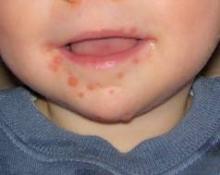The greatest risk factor for having herpes zoster during childhood is a history of acute varicella under 1 year of age. Fortunately, postherpetic neuralgia following herpes zoster is rare in children.
Hand-Foot-and-Mouth Disease
In a recent nationwide epidemic of severe hand-foot-and-mouth disease (HFMD), patients presented in clusters with fevers and a more widespread HFMD eruption than is characteristic of the self-limited disease, noted Dr. Mancini. Hospitalization was common, and blistering was prominent, with frequent perioral involvement and lesions on the arms and legs in nearly half of patients.
Of note, post-HFMD nail matrix arrest, first recognized by Dr. Mancini and his colleague (Pediatr. Dermatol. 2000;17:7-11), presents on average 40 days after exanthematous illness. Deep transverse ridges with nail shedding occur, more often affecting fingers than toes, and the process is self-limited with eventual spontaneous nail regrowth.
Gianotti-Crosti Syndrome
This syndrome was classically described in association with acute hepatitis B infection, although it is becoming exceedingly uncommon in the United States, where EBV appears to be the most common cause. Patients present with upper respiratory infection prodrome and monomorphous edematous papules on the cheeks, extensor extremities, and buttocks.
While the patient should be assessed for gastrointestinal symptoms, hepatosplenomegaly, lymphadenopathy, and hepatitis risk factors, blind hepatitis blood evaluations are not warranted in this country, Dr. Mancini said. The condition typically resolves in 3-12 weeks with supportive therapy.
Unilateral Laterothoracic Exanthem
Another atypical, parainfectious exanthem, unilateral laterothoracic exanthem, also known as "asymmetric periflexural exanthem," usually presents in children 1-5 years of age. It is initially unilateral in distribution, most often starting in the axilla or on the trunk or flank. At this stage, it may be misdiagnosed as contact dermatitis. The process eventually becomes more generalized, although it tends to maintain a unilateral predominance. Sixty percent of children have associated pruritus, Dr. Mancini said.
A prodrome occurs in 60%-75% of patients, and may include rhinitis, pharyngitis, and gastrointestinal complaints. Fever occurs in roughly 50% of patients, and while the etiology is unknown, it is believed to be a viral-associated exanthem. unilateral laterothoracic exanthem resolves over a 4- to 8-week period with supportive therapy.
Dr. Mancini reported having no relevant financial disclosures. SDEF and this news organization are owned by Frontline Medical Communications.


